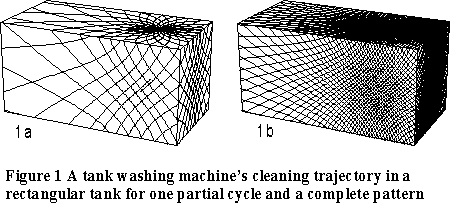
TANK CLEANING WITH A ROTARY WASHING MACHINE
PART I. A POWER-LAW MODEL DESCRIBING MOBILIZATION OF
PRODUCT RESIDUES.
D.G.F. Verbeek
H.E.A. van den Akker
Kramers Laboratorium voor Fysische Technologie
Delft University of Technology
Prins Bernhardlaan 6
2628 BW Delft
Netherlands
Abstract
A model has been derived for describing mobilisation of product residue
left at a tanks interior during the process of cleaning with a revolving
and jetting tank washing machine. In this model the cleaning takes place
trackwise due to the way the water jets build their pattern across the
walls. The contamination of the inner surface is represented with a so-called
`traxum function'. This traxum function is related to a peripheral parameter
that identifies the position on the walls. It was concluded, that the mobilization
of product residue and the concentration in the washing water both behave
as powerlaws, differing 1 in their exponents.
Introduction
Cleaning of tanks is a necessary, costly and repetitive problem in many branches of industry. In order to prevent contamination or decay a layer of soil must be removed before the next batch is introduced. Soil is defined as any kind of unwanted contamination, e.g. bacterials, depositions, product residue, etc.
A very common method for cleaning tanks is by means of washing with
revolving tank washing machines. Stationary or rotating spray balls are
left out of consideration. The machines meant in this series of papers
direct a number of fluid jets towards the inner surface of the tank, whilst
the spraying nozzles make a characteristic double rotational movement.
The fluid serves two purposes: First, it mobilises the sticking soil; second,
it acts as transport medium for draining the mobilised soil from the tank.
The specialism of tank cleaning is still a matter of experience. The
subject is almost completely absent in the scientific literature [1]. The
only available model developed by Schuurmans and Schilder [2] is therefore
still considered as state of the art [3, 4]. Their model, however, was
developed for an antiquated type of tanker ships, where a large pool of
liquid used to be present in the drain area of the tank. This pool containing
most of the product residue determined the cleaning rate of the tank according
to a dilution mechanism. Most industrial and ship tanks no longer have
such a large pool of liquid present in the drain area.
Our new model for tank washing, announced at the MariChem 1991 Conference
[5], focuses on the mobilization behaviour of the soil clinging to the
tank walls. It was emphasized that the jets of the tank washing machine
clean the tank track-wise. Pictures of this track-wise cleaning have been
given elsewhere [6]. This paper presents the full derivation of the new
model.
The working principle of a tank washing machine
Given that the cleaning fluid (mostly water, occasionally with cleaning
chemicals) is being distributed over the inner tank surface by means of
jetting, the first step in deriving a tank cleaning model is to describe
the motion of the jets.
The nozzles of a tank washing machine make a revolving motion around
a horizontal axis on the machine, while the machine itself rotates around
a vertical axis. The impingement points of the jets coming from the nozzles
follow a complex trajectory over the tank's inner surface. The rotation
speeds of the machine and of the nozzles are chosen to be different in
such a way that the trajectory of the impingement points forms a progressing
pattern that systematically covers the entire inner surface of the tank
after a certain time of washing.
The time a machine needs to complete its motion to the effect that the trajectories cover the entire inner tank surface is usually called the cycle time; the pattern is called a cycle (see figure 1a). Most machines produce more than one cycle within a washing pattern, that is completed the moment the jets start exactly duplicating the trajectories over the tank walls. During the consecutive cycles of a washing pattern the meshes between the trajectories of the earlier cycles are reduced by twining new trajectories in between, until the machine is exactly back at its original starting position (see figure 1b).

In view of the model to be developed two concepts must be defined first:
• The smallest element in the motion of the machine will be called a 'track motion' and is defined as: the motion of one of the nozzles during one revolution around the horizontal axis.
• A 'track' is then defined as the trajectory over the tank's inner
surface followed by the impingement point of a jet during a single track
motion of the corresponding nozzle.
Compared to the track motion, the description of a track is usually
more complicated since it requires an additional representation of the
shape of the tank and the position of the machine. In order to avoid this
kind of difficult descriptions, it is assumed in the derivation below that
the tank has a vertical cylinder symmetry and that the machine is located
at the symmetry axis.
The two rotational movements of the nozzles and of the machine body are usually both uniform. This implies that every track motion is congruent to all the others and differs only in the amount of pre-rotation around the vertical body axis. Due to the assumed cylinder-shape a similar congruence exists also in the shape of the tracks.
The shape of the track motions depends only on the ratio of the two
rotation speeds which is a machine constant. For the majority of machines
this ratio is close (but unequal) to unity. One track of such a machine
in a spherical tank would look like the 8-shaped line in figure 2.
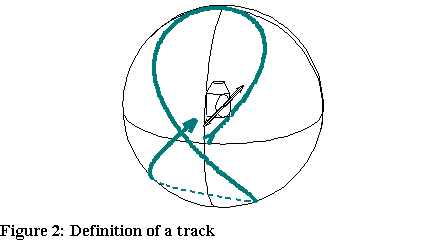
The three-dimensional character of the trajectories on the tank walls
is reduced with the help of the above concept of tracks. The complicated
pattern of trajectories is first decomposed into its constituent parts,
viz. the tracks.
The horizontal plane through the machine is chosen as reference. The
dissection of the plane with the tank wall is chosen as reference line
and is defined as the 'equator line'. Then, as can be seen in figure 2,
a track crosses the equator line twice, viz. one time in downward and one
time in upward direction. If the location of one of these crossings is
chosen as descriptive parameter, denoted by X, it will determine
uniquely the peripheral position of the entire track in the tank (upward
and downward). The crossing in the south to north (upward) direction is
chosen to represent the track and the track motion. By doing so the three-dimensional
reality has been collapsed onto a circle viz. the equator.
By definition X will be made dimensionless by dividing by the length of the equator, so the periphery parameter obeys:
![]()
The point X=0 is chosen such as to avoid extra parameters accounting
for the machine's starting position with respect to the equator.
The new parameter X will be used for describing the progressing
washing pattern of the machine around the periphery of the tank. Compared
to a time description in polar coordinates, the advantage of this exercise
is that it reduces the required number of dimensions from two to one.
The nozzles of a tank washing machine are normally in a fixed position with respect to one another, aiming in directions that divide a circle into equal parts (equal mutual angles). After the first equator crossing has taken place, the next intersection happens when the nozzle block has rotated over 1/Nnoz of a full rotation, where Nnoz equals the number of nozzles.
The time interval between two successive crossings is given by:

The machine body rotates in this time interval over an angle
2 Wb Dt, which can be expressed in a peripheral distance as:

The kth intersection of the equator is taking place at location:

where the integer j is chosen so that ![]()
With  the equator crossings taking place as a function of time at locations :
the equator crossings taking place as a function of time at locations :

The description of local soil on the inner tank surface
The leading idea of simplifying the description of the spatial distribution
of soil over the tank walls is to assign to each point on the wall a peripheral
value, which is the interpolated X-value of the two tracks the point
lies in between. Reversely, each value of X is assigned to a set
of locations that form a line over the inner surface of the tank from south
pole to north pole.
The transformation used for describing the spatial distribution of immobile
soil is explained here in an experiment of thought (see figure 3). Before
the washing starts, lines are drawn on the tank's inner surface corresponding
to the upward parts of all the tracks of the complete washing pattern (fig.
3a). Next, this procedure is repeated but now with the machine body rotated
over a very small angle so that new lines are positioned between the lines
that were already there. This procedure is repeated as often as necessary
to obtain a finite number of lines that is large compared to the number
of tracks in a complete washing pattern (fig. 3b).
Each of these lines has a unique value of X. Provided that all
locations in the tank can be reached by the jets (no shadow area condition),
the pattern formed by the lines just covers once the entire inner tank
surface. Due to the congruence of track motions, none of the lines crosses
another line. In the limit case, when the number of lines becomes infinite,
every location on the wall lies on only one of the lines and each value
of X corresponds to one of the pole to pole lines.
At some moment of interest during the washing process the tank is cut open along the above lines (fig. 3c and 3d). All the pieces together represent once and just only once the total inner tank surface. Since each line can be identified by its equator crossing position, each piece corresponds to a peripheral value between Xp and Xp + dX = Xp+1, where dX represents the peripheral width of the pieces.
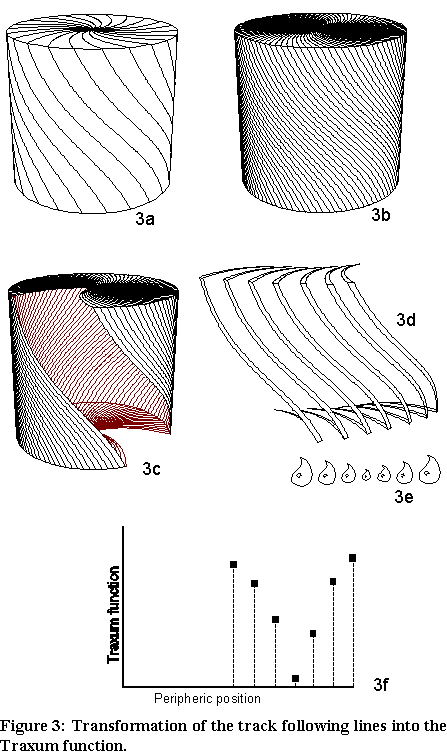
A representation of the contamination is possible by considering the total amount of immobile soil present on each individual piece. This idea will be called "TRAXUM".
With the local contamination on the wall given by C" [kg/m2], the traxum, Sp, of the pth piece from our experiment of thought is defined as:

In words: the traxum equals the total amount of soil clinging onto the wall between two neighbouring pole-to-pole lines of the experiment of thought divided by their mutual peripheral spacing.
In figure 3e each of the drops represents the total amount of clinging soil on one of the pieces of wall. The traxum equals the weight of the drops divided by dX. Each of the dots in figure 3f represents one of these traxum values or drop weights. The combined collection of traxums is the transformed representation of the contamination on the inner tank surface. The total amount of immobile soil in the tank, M, can be found as the summation of all the traxums:


Now S(X) is a continuous function of the continuous parameter
X and is called the "TRAXUM FUNCTION". It is a sort of density
function expressing per length of the periphery the amount of contamination
along a line from pole to pole over the inner tank surface. The total immobile
amount of soil in the tank can be found by means of integrating the traxum
function over its entire peripheral domain:

Track-wise substance removal
The next step in deriving a model for tank cleaning is to find the effect of track-wise washing on the S(X)-representation of the contamination in the tank. The little knowledge of the removing of soil by traversing impinging jets comes mostly from observations in visualization tests. No useful literature on the subject has been found.
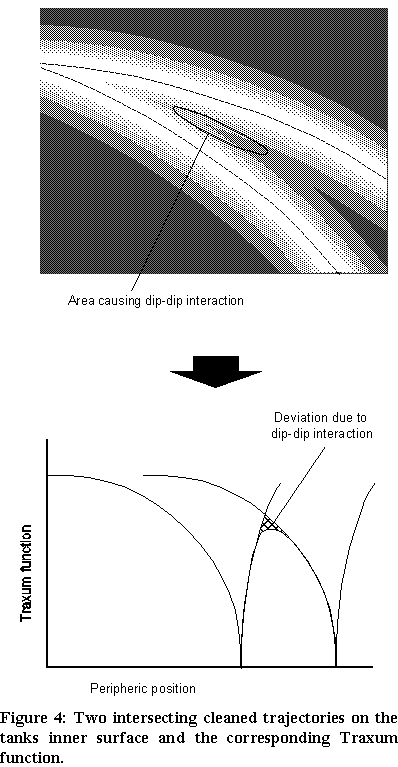
The washing water removes the product residue by dispersing or dissolving mechanisms (evaporation is left out of consideration here). This substance removal is the result of a variety of mechanical actions of the washing water, such as the impingement zone of the jet, the film of water running down the walls and splashing water. For the model it is not important which of them removes a particular piece of soil, the effects are considered to be additional. If it is further assumed that the influence of pushing aside and resettling of previously mobilised soil is rather small, the implication is, that once a certain location has been cleaned, it can not be cleaned again by any of the cleaning effects.
All contributing cleaning effects have in common that substance removal
is less likely to take place at larger peripheral distance from the track.
This means that the effect of a track on the traxum function will always
be a dip with its minimum on the corresponding value of X. The dip
is due to the large correlation between the actual track and the way the
traxum function is calculated. During the upward part of the track, the
jet impingement point traverses over the entire corresponding integration
line. On the condition that the jet is normally able to remove the substance,
this means that along the integration line all soil is removed and that
the minimum in the dip S(X) is approximately zero. During the downward
part of the track the jet removes about the same amount of soil as during
the upward part; as a result the dip widens. This will further be discussed
in appendix A in the context of figures 7 and 8.
The traxum is the representation of soil clinging onto the wall along a line drawn over the inner surface in only one pole-to-pole direction. A track being defined as the result of a full nozzle rotation, the dip is due to the cleaning action along the complete track (the jet moving in both pole-to-pole directions). The cleaning operation along the complete track is attributed to an integration line which is upward only.
Due to the assumed cylinder symmetrical situation, at the start of the washing process
S(X) = constant = M0.
The exact location X0 of the first track is irrelevant. The next tracks, however, will be made on the inner surface of a tank that has already partially been cleaned. The essential question is how they change the traxum function that is no longer constant. An answer may be found in figure 4a, which gives an impression of two trails in the dirt on the top surface of the tank around the pole where all tracks cross. The two dotted lines are the traxum integration lines corresponding to the peripheric positions where the two tracks are made. As is clear from the figure, cleaning of a particular place on the wall is only rarely the action result of more than one track. Only within the elliptical area the tracks may remove a certain amount of soil.
The thick line in figure 4b sketches the corresponding traxum function.
The shape of the two track corresponding dips is chosen more or less arbitrary.
The marked area is due to the substance removal caused by the cooperative
cleaning in the elliptical area. Since by definition the area under the
traxum function represents the amount of soil in the tank, it is clear
from the figure that collaborative cleaning hardly has any effect on the
total amount of substance. It seems therefore reasonable to assume that
every track causes the same kind of dip in the traxum function, affecting
only the remaining area under the curve of S. The process of substance
removal by the on-going addition of tracks to the developing washing pattern,
is now represented by the area under a traxum curve, which is getting smaller
by the addition of identical dips.
Machine dependent soil removal
The next step in deriving a model for tank cleaning is to find a
description for soil removal during the progressing pattern that systematically
covers the inner tank surface with tracks and cycles.
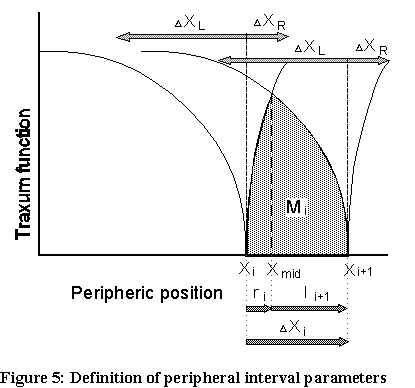
For the prediction of the amount of immobile soil in the tank as a function of time it is sufficient to describe (the shape of) the first dip in the traxum function, since all of the following dips were assumed to be identical. Unfortunately this shape depends on numerous effects and parameters. Trying to describe these lies far beyond the aim of this paper. Instead, it is assumed that within the peripheral interval Xi-DXL to Xi+DXR (see figure 5) the traxum function can be approximated by power laws for both sides of the ith dip:

where Xi is the peripheral location of the corresponding track. The integer i counts the tracks in the order they are lying next to one another in the momentarily progressed washing pattern on the moment of interest. In the derivation given below it is allowed that the left-hand side and the right-hand side of the dip have different slopes, as represented by the different constants aL and aR. The constant b, which affects the shape of the dip, has to be chosen equal for both sides.
At a certain moment, t, during the washing process let Xi and Xi+1 be the positions of two neighbouring tracks in the momentarily progressed washing pattern and let

In equations 12 and 13, Mi equals the dome shaped x-hatched area as shown in figure 5. In order to find the total amount of immobile soil in the tank all areas between the dips simply have to be added. The condition of overlapping validity intervals is automatically fulfilled for all spacings between the tracks when after a sufficiently long time of washing the pattern has become dense enough. From that moment on the total amount of immobile soil in the tank obeys:

where Ntr equals total number of tracks made by the machine since the start of the washing process.
Equation 14 describes the total amount of immobile clinging soil in the tank at any time during the washing process. In this case the time is expressed in terms of Ntr. The washing time can be found by multiplying Ntr with Dt of equation 2. The configuration of spacings DXi constantly changes due to the addition of new tracks to the pattern at locations Xk of equation 4. By calculating the sum of equation 14 after every track made, the soil removal can be followed in time. An example of such an exercise for three different existing machines is plotted in figure 6. The figure shows a log-log graph of the dimensionless amount of soil M/M0 versus the time expressed in the number of tracks made.
The first machine has a rather slowly progressing pattern, which means that a large fraction of the tank's inner surface remains unwashed until the first cycle is completed. This causes the large bow in the corresponding graph. Due to a bad design the trajectories of the jets start overwriting each others pattern after the first cycle. This means that no more dirty places are being hit and according to the power law model that no further cleaning takes place. This causes the horizontal line in the figure.
The second machine is a very common two nozzle machine and the third
machine is the same machine but equipped with four nozzles. The graph shows
clearly that machine 2 performs much better than machine 1 and that machine
3 is the best out of three. Better cleaning performance means here that
during the washing process a much larger fraction of the soil has been
mobilised.
Generalised machine behaviour
The three machines in figure 6 were chosen as examples for their differences in washing performance. In order to develop a theory for tank cleaning it is necessary to find a common behaviour that applies for all machines.
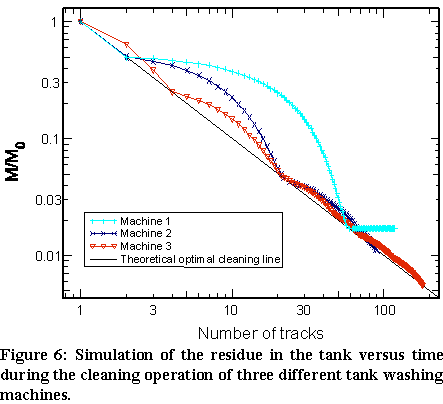
A fourth line, plotted in figure 6, has been marked 'optimum cleaning
line'. The common factor between the machines is: on the moments that the
pattern is distributed regularly over the tanks periphery, the machine
performance equals a point on this optimum line. At all other moments the
cleaning performance was less efficient meaning a larger value of M(Ntr).
The optimum line is the collection of best machine performances. Any point
on this line corresponds to a homogeneously distributed washing pattern
with spacings between the tracks that all equal each other. It is shown
in appendix C that this leads indeed to the highest amount of soil removal
per amount of tracks.
For the derivation below it is sufficient to know that the generalised machine behaviour is characterised by a pattern of equidistant tracks at all times. Actually such a machine cannot exist; should at certain moment in time the pattern be regularly distributed, the next track must divide one of the spacings, destroying the regularity of the pattern.
For the spacings it follows:




Time dependent amount of soil
The translation of the discrete time behaviour, expressed in a number
of tracks, to a continuous time behaviour gives an extra complication.
The rate at which tracks are made by the machine is given by

M(t=0) = M0 does not fit into this model. In the limit case of going to zero, equation 17 reaches infinity. A simple way of dealing with this problem is to interpret Ntr as the track that is momentarily being made, so Ntr = 1 as soon as the washing process has started. In real time this means that the power law function shifts to the left over a time interval, t0.
For the immobile amount of soil as a function of time follows:

The conclusion is that t0 is a new fitting parameter that
depends on the steepness of the dips in the traxum function and therefore
on the kind of soil, the water jets and the tank design.
The dimensionless form of equation 18 takes the form:

By assuming, that the time needed for the mobilised soil to stream down the walls is negligible and, that all of the fluid is immediately drained, it is possible to describe the soil concentration in the effluent of the tank as a function of time.
Since the washing water acts a transport medium, all of the mobilized soil must be contained in the tank's effluent. The fundamental equation is

Differentiation of equation 19 yields



Discussion
The description of tank washing faces the difficulty of an enormous amount of needed parameters, for most of which no theory is available. The only available model, that of Schuurmans [2], only described the dilution behaviour of the pool of liquid present around the deepwell pumps in tanker ship tanks. The power-law model is an attempt to describe the cleaning process in terms of mobilising soil and trackwise cleaning of the tankwashing machine. It was actually developed as a model for describing differences in washing patterns, but turned out to be succesful in describing the observed and measured phenomena.
The first few track-movements remove the highest amount of substance and establish a rough pattern of tracks. The rest of the cleaning is characterised by the fact that more tracks are twined in. Soil removal takes only place in the meshes, that become smaller in size and larger in number by the ongoing intersecting with new tracks. Cleaning the tank is therefore a logistic problem of hitting the entire inner surface of the tank at sufficiently high intensity.
The general belief under tank owners that the cleanliness of the tank can be judged by the effluent concentration is justified by Schuurmans' tank cleaning model, according to which the amount of soil and the effluent concentration both decrease according to the same exponential function. The power-law model predicts a different behaviour. The concentration in the tank's effluent is related to the rate of mobilising soil and not to the cleanliness of the tank. It is therefore an important conclusion that when M decreases with time to the power b, the concentration decreases to the power b -1. The effluent concentration gives the impression of a much cleaner tank than it in reality is. Measurements proving this conclusion are given in Part II [7].
A number of assumptions had to be made for the derivation of the model.
It is rather difficult to discuss the assumption that the flanks of the
dip in the traxum function, caused by a track, can be fitted by power-law
functions. The important conclusion is, that the assumption resulted in
power-law descriptions for the effluent concentration and the time decreasing
total amount of soil in the tank. Reversely, deviations from this measurable
behaviour may make it possible to draw conclusions about the actual shape
of the dip.
Conclusions
- The new model for tank cleaning complies with the idea that the essential
rate determining step in cleaning is the process of mobilizing soil from
the tank's inner surfaces.
- The amount of soil on the inner surface can be represented in a simpified
way by a traxum function, depending on a periphery parameter. The location
of the tracks of the impingement points of the jets of the tank washing
machine can be expressed in the same parameter. Every track causes a dip
in the traxum function with its minimum at the corresponding peripheral
location. Every dip affects only the remaining area under the momentarily
developed traxum function.
- According to the presented model for revolving tank cleaning machines,
the amount of immobile soil on the inner surface of the tank decreases
in time roughly according to a power-law function. This is the result of
the way a tank washing machine refines its pattern and of the assumption
that almost any system within a certain range of parameters reacts as a
power law.
- The soil concentration of the tank's effluent also obeys a power law
function. Compared to the amount of immobile soil on the inner surface
the concentration decreases approximately one decade/decade faster. Since
the effluent concentration depends on the cleaning rate rather than on
the degree of cleanliness of the tank, this faster decrease, gives the
false impression of a tank being much cleaner than it in reality is.
- The task for a tank washing machine is to hit all the locations in
the tank with its jets. The cleaning rate is the result of the logistic
effectiveness of the machine. The best machine is characterised by a homogeneous
distribution of tracks. Actually, the cleaning performance equals the idealised
power-law behaviour, only at the moments the washing pattern is regularly
distributed over the tanks periphery; at all other moments the cleaning
performance is less efficient.
Literature
[1] MSA Research Corporation: Tanker Tank Cleaning Research Program, Phase I final report, MSAR 74-36, U.S. Department of Commerce Maritime Adm., 1974
[2] H.J.A.Schuurmans, J.G.M. Schilder, Prewash procedures for chemical tankers, Monograph 35, june 1979, The Netherlands Maritime Institute
[3] J.B.Riksheim, Cargo tank washing under MarPol Annex II opportunities and limitations, Marichem conference paper 2.2, December 1989,
[4] J.Langhorn, A comprehensive answer to difficult tank cleaning, Marichem conference paper 8.5, December 1989
[5] Akker H.E.A. van den and D.G.F.Verbeek, A new model for tank cleaning in view of emerging IMO regulations. Marichem Conference paper 8.3, December 1991
[6] H.E.A. van den Akker and D.G.F. Verbeek, Nieuw uitspoelmodel helpt reinigen van tanks te optimaliseren, PolyTechnisch Tijdschift Procestechniek, 47, 12, 1992, pp.34-38, (in Dutch) .
[7] D.G.F. Verbeek and H.E.A van den Akker, Tank Cleaning with a rotary
washing machine Part II The complete model validated by experiments, Submitted
to Chem.Eng.Sci.
Appendix A
Washing effects and traxum dip construction
Three mechanical effects in the behaviour of the washing water have been observed as largest contributors to the total mobilization of soil.
The first is the cleaning effect of the film of washing water running down the vertical walls. The effect is especially relevant for easily removable substances. Figure 7 sketches the shape of the area covered by one track of a common washing machine on a vertical cylinder wall. The same figure shows how the corresponding dip in the traxum function can be constructed for the case that the film removes all of the local soil. Since the slopes of the dip are almost straight lines, a value of b 1 can be assumed.
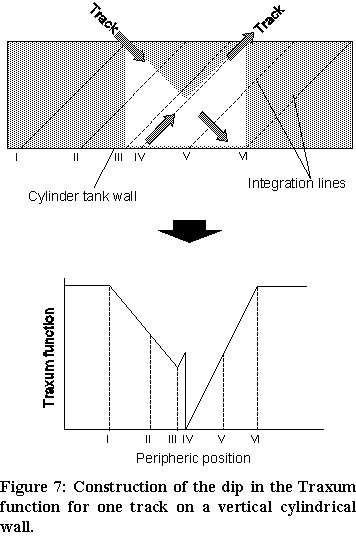
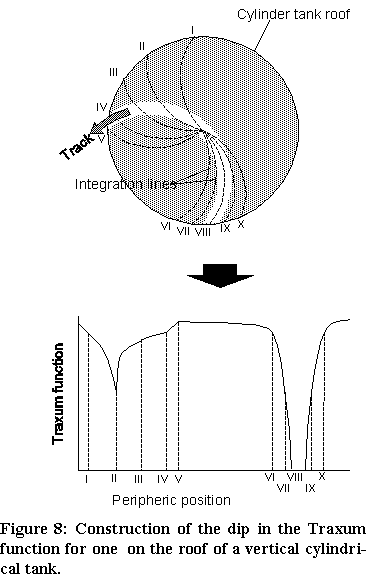
The second cleaning effect is due to the large shear stress in the impingement
region of the jet. In this region most of the soil is removed instantaneously.
The tracks become visible as cleaned traces in the soil on the wall. Variations
in the width of the traces have been observed during visualisation tests
varying from centimetres to meters. The effect proved to be important for
all highly viscous substances and for the (flat) roof of the tank where
no influence of the first effect exists. Figure 8 sketches the construction
of the dip in the traxum function caused by this cleaning effect on the
roof of a cylindrical tank. The extra dip opposite to the actual track
location is caused by the fact that all integration lines meet in the poles
above and below the machine. But since this is also the case for the tracks,
this location receives the highest amount of water and will be the first
that can be considered clean. Once this is the case it can no longer disturb
the power-law model.
A third effect is due to water splashing away from the impingement point
of the jet. The range of splashing directions depends strongly on the impingement
angle of the jet and therefore on the tank design. In general, however,
this cleaning effect seems to be relevant only within approximately half
a meter from the lines where planes of the inner surface meet other planes,
e.g. the line between the roof and the vertical wall. Splashing affects
the traxum function usually only within a small peripheral interval around
the track location.
Appendix B
The soil between two peripheral positions
Let Xi and Xi+1 be the positions of two neighbouring tracks in the momentarily progressed washing pattern. The distance between the positions is small enough to ensure that the validity intervals of equation 9 overlap sufficiently.
Let Xmid be the location where the two corresponding
dips in the traxum function equal each other (see figure 5). Define the
following peripheral intervals:
The continuity of S at the point Xmid yields:
The distances ri and li+1 can be expressed in terms of the peripheral spacing between the tracks. Combining of equations B.3 and B.4 leads to:





Substituting equations B.5 and B.6 in equation. B.8 leads to:


If the dip in S(X) can be approximated by a power law function,
as given in equation 9, equation 13 shows that the amount of soil between
the two peripheral positions only depends on the distance between the tracks.
Appendix C
The optimum cleaning line
Equation 14 can be written in the form




The extreme value is a minimum since

Symbols
A surface [m2]
C concentration [kg m-3]
C" immobile wall contamination [kg m-2]
i peripheral counter for momentarily configuration of tracks
k counter representing following order in time
l peripheral interval left from track
M immobile amount of soil on inner tank surface [kg]
N the (total) number of
N'tr rate of tracks being made [tracks s-1]
r peripheral interval right from track
S Traxum or traxum function [kg]
t time [s]
t0 time constant for the power law model [s]
V Volume of the well mixed hold-up of washing fluid [m3 ]
X location parameter for the Traxum function [dim.less]
a slope constant for the power law model [dimension depends on equation]
b constant in the exponent of the power law model [dim.less]
f volume flow rate [m3 s-1]
W rotation speed [rad s-1]
Operators
d the differential operator
mod the modulo operator
D a variation in the parameter following D
d an infinitesimal variation in the parameter following d
Subscripts
b of the body of the machine
end at the end of the washing process
n of the nozzles
noz nozzles
i peripheral counter for the tracks
k counter for following order in time
L left side
mid the point where two neighbouring dips in the traxum function are equal
mob mobile
0 at the start of the washing process
p peripheral counter for traxum pieces of wall
R right side
tot total
tr tracks